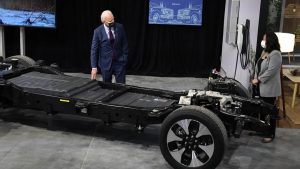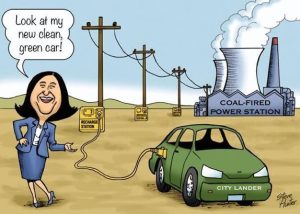While test driving an EV recently, I came upon an interesting display (inside the EV) that tells us a lot about EVs. It tells how much power is used to move the EV and how much power is used up to power other things, such as the EV’s electrically powered accessories – including its thermal management system, which is a kind of AC/heater for the battery. An EV’s battery needs to be maintained within certain temperature parameters in order to keep it “healthy” – and able to receive a charge. Too cold – or too hot – being unhealthy.
But the take-home point is an EV has – effectively – two AC and heating systems and one of them is always on.
Even when the vehicle is off.
According to the display, this accounted for 9 percent of the draw on the battery. Another 9 percent went to power accessories such as the lights, the stereo and the heated seats. And 18 percent went to power the AC and heater – for the people inside the EV. Add them up and you get a 40 percent loss, according to the display. Put another way, only about 60 percent of the battery’s charge went to move the EV.
This is one of the several reasons why EVs don’t have much range – and need to be recharged so often for just that reason.
A compounding factor is that current technology lithium-ion battery packs can only hold the energy equivalent of about half a tank of gas. They could hypothetically hold more but then the battery would be as big as the EV and weigh so much the EV would need more power to move . . . which would require an even bigger battery . . .
You see the problem.
None of this is a problem with the vehicles the government is using its regulatory python to strangle off the market.
It is true that gas-burning engines only convert about 60 percent of the energy in gasoline into productive work; i.e., moving the vehicle. This sounds bad but – relative to battery-powered vehicles – it is very good. Not because there is also a 40 percent loss. But because the 60 percent is functionally more – in terms of how far you can go.
Keep in mind that a gas-powered car can carry enough gas to offset the energy losses. A typical car has a 15 gallon tank that stores enough energy to propel it more than 400 miles (assuming 30 MPG) and all of this stored energy only weighs about 100 pounds (a gallon of gas weighing about 6 pounds and a gas tank weighing next-to-nothing). So it isn’t weighed down by the liquid energy it carries. And the weight gets less as the energy is used.
A battery weighs the same whether it is “empty” or “full.”
And it is very heavy – 800-1,000 pounds being typical for a small EV.
It’s pretty wasteful, lugging all that weight around.
It costs no additional energy to heat the cabin of a gas-powered car as the heat is a waste byproduct of moving the car. And there is no separate heater (and AC system) to heat the battery, because there isn’t one – other than the 12V battery that starts the engine – and it doesn’t need to be heated.
A gas-powered vehicle also does not burn energy just sitting, parked. You can leave it parked for weeks – and when you go back to driving it, you have exactly the same amount of energy remaining as you did when you left it parked. In this scenario, the gas-powered vehicle is a true zero emissions vehicle – but the electric vehicle isn’t, because it is continuously burning power even when it’s parked and in order to avoid not having any (or enough) when you go back to driving it after leaving it sitting overnight (or longer) it is necessary to feed it power, as by keeping it plugged in.
This power doesn’t come from the outlet. It comes from a utility plant – which probably burns hydrocarbon fuel to generate it. This generates the dread gas carbon dioxide, which we’re told it’s absolutely necessary to “emit” zero of in order to prevent the climate from “changing” (a neatly unscientific term that be literally anything, which is exactly why that term is used rather than global warming, which can be challenged using facts that it’s not happening).
Yet the EV gets a pass, even though it “emits” – or causes to be emitted – the gas that force-feeding us EVs is supposed to staunch the “emitting” of.
Even when it’s not in use.
Spectacular, isn’t it?
. . .
If you like what you’ve found here please consider supporting EPautos.
We depend on you to keep the wheels turning!
Our donate button is here.
If you prefer not to use PayPal, our mailing address is:
EPautos
721 Hummingbird Lane SE
Copper Hill, VA 24079
PS: Get an EPautos magnet or sticker or coaster in return for a $20 or more one-time donation or a $10 or more monthly recurring donation. (Please be sure to tell us you want a magnet or sticker or coaster – and also, provide an address, so we know where to mail the thing!)
If you like items like the Keeeeeeev T shirt pictured below, you can find that and more at the EPautos store!












FYI, technically “discharged” versus “fully” charged batteries do have different weights. the total mass of a battery increases when the battery is charged and decreases when it is discharged. Albeit it at the size of the bEV it would be nearly negligible to measure accurately. The old E=mc2, formula comes into play as “energy” does have mass.
https://toolsweek.com/do-batteries-weigh-more-when-charged/
Also interestingly, batteries will “bounce” when in a discharged state, as the chemical materials change depending on the “charge” or “discharged” state.
Hi Damion,
That’s true, but the difference is negligible. On the other hand, an empty gas tank weighs almost nothing. And even when it full, it only weighs (typically) about 100 pounds (the weight of roughly 15 gallons of gas at 6 pounds per). A typical EV battery, on the other hand, weighs in the vicinity of 800-1,000 pounds. And it doesn’t get appreciably lighter as it discharges.
This fine article came across the feed a few days ago. Turns out, EVs are better than ICEs in cold weather! Your test vehicle must have a fault. LOL
It was said that if Pravda’s weather forecasters called for sunshine everyone in Moscow knew to carry an umbrella. The level of delusion necessary to pen this sort of revisionist thinking is borderline schizophrenia.
https://arstechnica.com/cars/2023/12/electric-vehicles-are-better-than-gas-powered-cars-in-winter-heres-why/
Wow, how much did GM pay that guy to write that article? Every sentence is loaded with so much BS I could barely read through the whole thing.
Electric motor bicycle goes all auto-immolation.
Scroll through the comment section to reach the video.
They’re coming to take everything, so none of it matters anymore.
“You may kill Thorndike.” – Nurse Charlotte Diesel, High Anxiety
Nurse Ratched would agree.
The Amish want to kill everybody!
Read it and weep, comrades:
‘One thing is certain: the EV bubble has popped. Just look at the numbers.
‘GM, Ford, Stellantis, and Volkswagen have all leaned into the EV trend, announcing billions in spending on battery plants and new models. Their combined market capitalization has gone from a peak of about $425 billion to $220 billion, down almost 50%.
‘All told, roughly $1.4 trillion in market value has been wiped out in the past couple of years as investors reassessed EV valuations.
‘EV technology isn’t dead. What’s gone forever is the sky-high valuations for EV start-ups years away from profitability.’
https://www.marketwatch.com/articles/electric-vehicles-stock-tesla-ford-gm-rivian-bubble-73c949c6
When you’ve lost EeeVee fanboi Al Roooooooot, author of this article, you know it’s ovahhhhh. 🙁
Despite tons of taxpayer dollars from the 2021 aimed at going toward building EV charging stations across the U.S., a whopping ZERO have been built…..
https://www.zerohedge.com/technology/zero-public-ev-chargers-built-congress-approved-75-billion-expand-network
There’s more pushback against the Biden Thing’s EV mandate….
https://thehighwire.com/news/biden-faces-massive-opposition-to-electric-vehicle-mandate/
What’s so great about a 60,000 dollar electric vehicle that can’t do squat?
Tell me why. There’ll be flying pigs when electric vehicles are dominating the numbers of total cars on the road.
Well, there are already some flying pigs out there, John Kerry, Bill Gates, Klaus ‘The Vampire Squid’ Schwab, also a slob of a hog.
Joe Biden is the number one flying pig, a more equal animal, looks just like a pig.
Nancy Pelosi is another flying pig, pigs can fly! Hillary knows how to fly like the pig she is. I’ll stop.
Was gone on a daily drive, drove a hundred miles, have to check things out at the farmhouse. Weather was good, 53 degrees F, made for a good distance to go and the highways are clear sailing. Good road conditions make it a magic carpet ride. I even bought some gas! The horror!
Bought premium gas, better gas mileage, cost is a wash.
No mice in the traps, the best news of the day.
It’s easy to make a pig fly. Put a decent bit of tangerine under a garden variety ground bound swine, shoot it with any old bullet, and, et voila! Flying pig!
Tannerite… thanks autocorrect!
The whole living creature ecosystem is dependent on CO2. Without CO2 all life comes to an end unless creatures rapidly change their metabolic system. The origin of the greenhouse effect of CO2 was conducted in a 1 liter closed vessel, which is totally unlike an open ended atmosphere extending upward for 150 miles plus the radiant heat from a shining star. The movement got traction when Margaret Thatcher said money was available for studies of CO2.
“A battery weighs the same whether it is “empty” or “full.” ”
And it weighs a lot, which means the car by itself, being heavier is less efficient, then as the car sits there is bleeds juice, meaning it is even more less efficient, then the charging time is long, which means it makes your time less efficient – which is critical when you exist in a DEBT BASED society and time is money.
Has it occured to anyone if we owned our cars and houses, why would we have to work?
So someone should crunch the numbers, if you have a nation of 100 million EVs and they are all bleeding juice, then a snowstorm hits, and they really bleed, but the energy is needed for heating homes. This is a recipe for a disaster, another Jew government forced scam, not thought out well, promoted by misinformation, meant to control us and meant to harm us.
THE MONEY SCAM MEANT TO HARM US
THE DEBT BASED MONEY IS MEANT TO ENSLAVE US
THE COVID SCAM IS MEANT TO KILL US
THE FALSE FLAG SCAM IS MEANT TO CAUSE US INTO WARS
and who is behind this evil, I will tell you, it’s the Jews
want proof?
TOP NOTCH INFORMATION, LOOKS LIKE THE GOYIM ARE ORGANIZING AGAINST THE PARASITES:
https://rense.com/general97/flyers.php
Thank you Mr. Cartman
What the promoters of ten-minute EV charging don’t tell you:
‘XFC [Extra Fast Charging] technology can deliver 400kW or more at 800Vdc, enabling drivers to charge an EV battery to 80% in 8 to 10 minutes. XFC can only be used with specially-designed battery chemistries, battery packs, and BTMS [Battery Thermal Management System].
‘A robust and oversized BTMS will be required to support XFC. The size of the BTMS is expected to increase from 1–5 kW to 15–25 kW. Frequent XFC use will increase the average lifetime cell temperature, negatively impacting cell cycle lives.’
https://www.batterypowertips.com/ev-battery-thermal-management-challenges-faq/
Never mind the cost of quintupling the BTMS capacity … and the even greater overnight loss of range which will result. The real absurdity is that if you actually use ten-minute charging — say, on a long-distance trip — it will shorten your battery life and maybe even void your warranty.
*cuckoo* *cuckoo* *cuckoo*
400 KW into a charging plug. Even at 800 VDC that’s 500 A current. Your connectors better be pristine or they’re going to quickly heat up and melt from resistance. These things are outdoors, exposed to all sorts of weather, and subject to use by the general public. Over time the pins will wear, sockets will be wallered out, and connections will corrode. I know the cable assemblies on the high speed chargers are liquid cooled but the pins themselves can’t be actively cooled, there’s just not enough surface area. I’m sure the engineers thought of this and will monitor for high temperatures and resistance, but the default mode will be to shut down or greatly reduce the current, negating the whole point of a fast charger.
Hi Jim,
Yup –
And even if these deficits could be eliminated, it’s still twice-plus as long a wait vs. filling up (to full). Imagine having to spend 10 minutes dicking around at a gas station twice a week – to get 80 percent full (and so 20 percent low).
Yet they keep pushing this increased hassle, time-suck and money-draw on us…
Another damn-fool thing mentioned in the linked article is that the water cooling of the 500-amp cable might need to be jacked into the vehicle’s battery cooling jacket, to suppress the dangerously high cell temperatures caused by zap charging.
Imagine plugging in to charge … and getting hot water spewed in your face.
Got hose washers?
Obviously, there’s nothing “extra fast” about a mere 80 % charge in as much as 8-10 minutes (!). For EVs to become viable, chargers need to perform a lot better than that…
EVs are often compared to their turn of the 20th century ancestors which were quickly supplanted by gas powered cars. But back then there was another form of transport that also had/has a huge similarity to EVs today. Horses. Yep – horses had many of the same drawbacks as EVs, and all without the animal-human bond that can be had with living things.
A horse consumes energy (calories from food) even when you are not riding it or using it to pull a carriage. And it consumes more when the weather is cold (as do all warm-blooded animals) as more energy is required just to keep warm. You have to provide food and water for your horse even when you aren’t using it….
And then you have to have a special setup to properly care for and house your horse, generally a stable or other structure for the horse to shelter in, and ideally some fenced land for it to wander around on when not being ridden.
By contrast, gas or diesel powered conveyances need no special accommodations – other than a suitable place to park. The only energy they use or require is when they are operational.
Just another way to take everyone (but the elites) back to the late 19th century – or earlier, since coal won’t be allowed either.
Horses do, however produce useful manure for growing things and can, under sufficiently bad circumstances, be eaten and their skin worn, so they are in fact superior to electric cars in every way.
Why fret about it? The intent of the EV is to hasten the destruction of the West, not save it from a scary molecular byproduct of combustion.
Vivek Ramaswamy discussing the stupid CO2 capture pipeline & the climate change hoax. Note that the youtube lefties have to add their little climate change propaganda header.
https://www.youtube.com/watch?v=N-GScIH2_y4
>Note that the youtube lefties have to add their little climate change propaganda header.
Not if you don’t view it through YouTube:
https://redirect.invidious.io/watch?v=N-GScIH2_y4
Pick the one nearest you and watch without ads, Google’s shitlib propaganda headers, etc.
That’s a useful tool –thanks.
Used to use ViewPure but it hasn’t worked (for me at least) in ages.
9 percent of power usage to maintain battery temp so what I wonder about is if you leave a fully charged EV in long term term parking at the airport and come back in 3 or 4 weeks would you be able to drive home? I used to do that with an ICE car in winter and summer and all was good.
Not the best idea ever in the winter. Summer you’d be fine. EV in a garage loses about 1% battery power 1-3 days depending on a # of factors. (Battery age, model, temperature, etc.)
Outside unprotected in very cold temperatures I would imagine that number would jump quite a bit probably 2-3% per day. You would NOT have been at full charge when you arrive at an airport. So yeah, the chance of coming back to a dead vehicle would be pretty high.
I actually had a car battery of the conventional lead acid type fail on me on a 90 degree day. I also understand high heat is bad for batteries too.
As I type this (around 8:30 Eastern), it is 34 degrees where Eric is, and going up to 50 today. Depending on where you live, the non-moving usage could be much higher than even 40 percent.
Something that Eric forgot to mention is that he plugged this ‘abortion’ of a pickup into his house for a 36 hour charging period, which netted a whole 36 mile gain to the existing range.
1 mile for every 1 hour of home charging; how do you like them rotted apples?
I’d rather have the then 25,-yo. Minnie Driver, whose phone number Will Hunting had gotten
‘the government is using its regulatory python to strangle off the [IC-engined] market.’ — eric
Meanwhile, here’s what happens when the regulatory python tries to promote ‘NEVI chargers’:
‘The federal government committed $7.5 billion as part of the Infrastructure Investment and Jobs Act to build 1.2 million public chargers.
‘However, despite more than $2 billion of the $7.5 billion in federal EV charger funding already authorized under the programs, not even half of states have started to take bids from contractors for construction—and not a single new public charger has been built.
“You have to go slow to go fast,” said Gabe Klein of the Joint Office of Energy and Transportation. “These are things that take a little bit of time, but boy, when you’re done, it’s going to completely change the game.”
https://tinyurl.com/w3dfytpa
Like Chairman’s Mao’s disastrous Great Leap Forward, which starved millions, Gabe Klein’s personal transportation “game changer” is a catastrophe in the making. It scandalizes me that we pay this blithering fool to harangue us with his destructive schemes.
Hi Jim,
That’s an excellent analogy – Mao’s “Great Leap Forward”. This insane push for “Net Zero”, etc. will have the same result here and in the EU, a giant fall backwards in living standards.
The whole of the Green New Deal is a Democratic wet dream of a payoff for their constituents. The Green communists love it, the labor communists love it, and the ideologues love it. After all, if the central planners don’t intercede there won’t be enough time to fight the War On Plant life. And where’s the free market providing the 28 million charging “ports” necessary to avoid destruction of all life on Earth from mankind’s “horrible mismanagement of the atmosphere?” Only our wise overlords can properly manage the air. Pay no attention to the manipulated data, the missed milestones or the odd behavior that seems to revert to the mean…
10% for accessories? That’s ~25 miles of range if we’re to believe the MPe as stated. Are you running one of those 12V microwave ovens for truckers while testing? LOL
This brings up a point though. The alternator, which is there primarily to generate a spark, has enough excess energy to recharge the SLA battery and run all sorts of accessories like the nav system, Blaupunkt, SAAAAAAFETY systems, theatre lighting, headlights, running lights, Christmas lights… all that electricity produced in a small ball of copper and iron and a little bit of the HP from the engine. The SLA battery, which is much larger than the alternator, will quickly drain to nothing if you leave the dome light on all night.
Generating electricity is easy. Transporting electricity, while infrastructure intensive, is pretty easy too. Converting electricity to work is easy.
Storing electricity is still very hard.
‘all that electricity produced in a small ball of copper and iron and a little bit of the HP from the engine.’ — ReadyKilowatt
The alternator load to run electrical accessories is essentially invisible, and almost negligible. An air conditioning compressor imposes a mechanical load which can cost 2-3 mpg: still not a major ding to range, when you have 300 to 600 miles available.
But with an EeeVee devoting 40% of its battery power to overhead loads, range shrinks alarmingly. Govco is shocked — shocked — that its peasants find this objectionable.
Joe’s in his ‘vette, and all’s well with the world. — alluding to Aldous Huxley, Brave New World, alluding to Robert Browning, “Pippa Passes”
Yup. Always add properly isolated 1kw additional battery storage for each kw of ac inverter, rms audio amp or ham radio “heat”. The highest output alternator available to fit a vehicle never hurts. That LA battery is for starting the engine and alternator. Carry jumper cables to help those failing to understand the above. ALWAYS connect them to dead vehicle yourself cuz “fail to understand” WILL connect them backwards EVERY time.
Red is negative and black is positive in DC bassackwords world.
And if you thought the whole EV infrastructure issue wasn’t already unrealistic, here is a new ‘unicorn fantasy’ to add to the whole asinine absurdity of ‘Net Zero’. Yes, I shit you not, WIRELESS EV CHARGING:
https://www.youtube.com/watch?v=035_O8g6wF8
How can you have a cell phone on wheels, if it don’t have the latest cell phone gewgaws?
How can you have any pudding, if you don’t eat your meat?
1 scoop Pea protein isolate with 1/3 cup warm water.
Denver RTD’s Fastracks light rail system is $2 billion over budget and no where near completion. Basically a big electric train network, the system is 122 miles of light rail and commuter lines. Paid for primarily through a regional sales tax, I doubt it will ever make payback, or even be operable on rider fees alone.
https://en.wikipedia.org/wiki/FasTracks
Latest news is they’re taking out the cushioned fabric seats and replacing them with vinyl because upkeep was too expensive. So now you’re on their schedule, you get an uncomfortable seat and still have to share space with the people who apparently were filthy enough to soil the nice fabric seats. And because a rate increase to cover the increased cost of maintenance would require a referendum or some sort of public meetings, that was a non-starter.
But the free market is the bad guys!
LOL! Taking out the fabric seats. They should just take out the seats altogether. Peasants can stand.
I was at the dealer this week getting my golf cart (aka Honda Fit) inspected to pass the ‘Ho’s road safety edicts (Hochul and NYS’ worthless safety inspections) and I asked the salesman where all the EV’s be at? He said they might get some in after the first of the year and at MOST they would maybe sell 10 EVs all year. Whoa Nelly! I told him that would never pass the Ho’s EV edicts set to start next year.
I guess we’ll see who wins out – the free market or the jack boot government edicts. I have lots of popcorn popped to watch this shit show.
I would be stunned if there were not a bias in this display that makes the EV look better than it is.
‘Gas-burning engines only convert about 60 percent of the energy in gasoline into productive work; i.e., moving the vehicle.’ — eric
This figure is too high, Eric: “According to MDPI of Basel, Switzerland, gasoline engines have a thermal efficiency of between 30% and 36%. The current BTE (Brake Thermal Efficiency) of diesel engines can reach 40 to 47%.”
https://rentar.com/efficient-engines-thermodynamics-combustion-efficiency/
No need to conceal or rationalize these low numbers: they are an unavoidable result of the Second Law of Thermodynamics, which applies to thermal electric power plants, too: like IC engines, they typically are 35 to 45% efficient.
This is why excluding from MPGe the unavoidable, large efficiency losses of generating electricity is a fraud. Traditional MPG takes the hit of 64% to 70% efficiency loss from combustion. Whereas MPGe pretends that electricity is immaculately conceived.
‘Your mileage may vary,‘ etc.
And that’s thanks to the energy density of gasoline. We can throw off 65-70% of the energy as unwanted (sometimes wanted) heat and still get more practical work out of an ICE than a battery driven electric motor.
Hi Jim. While that may well be true come winter you’ll be glad that the waste heat from the engine will keep you warm and toasty without effecting its range an EV on the other hand will lose range keeping you warm and toasty barring a battery fire but that’s pretty well a single use option :-).